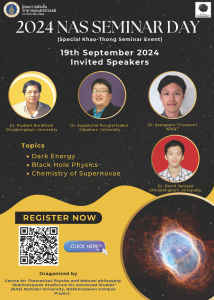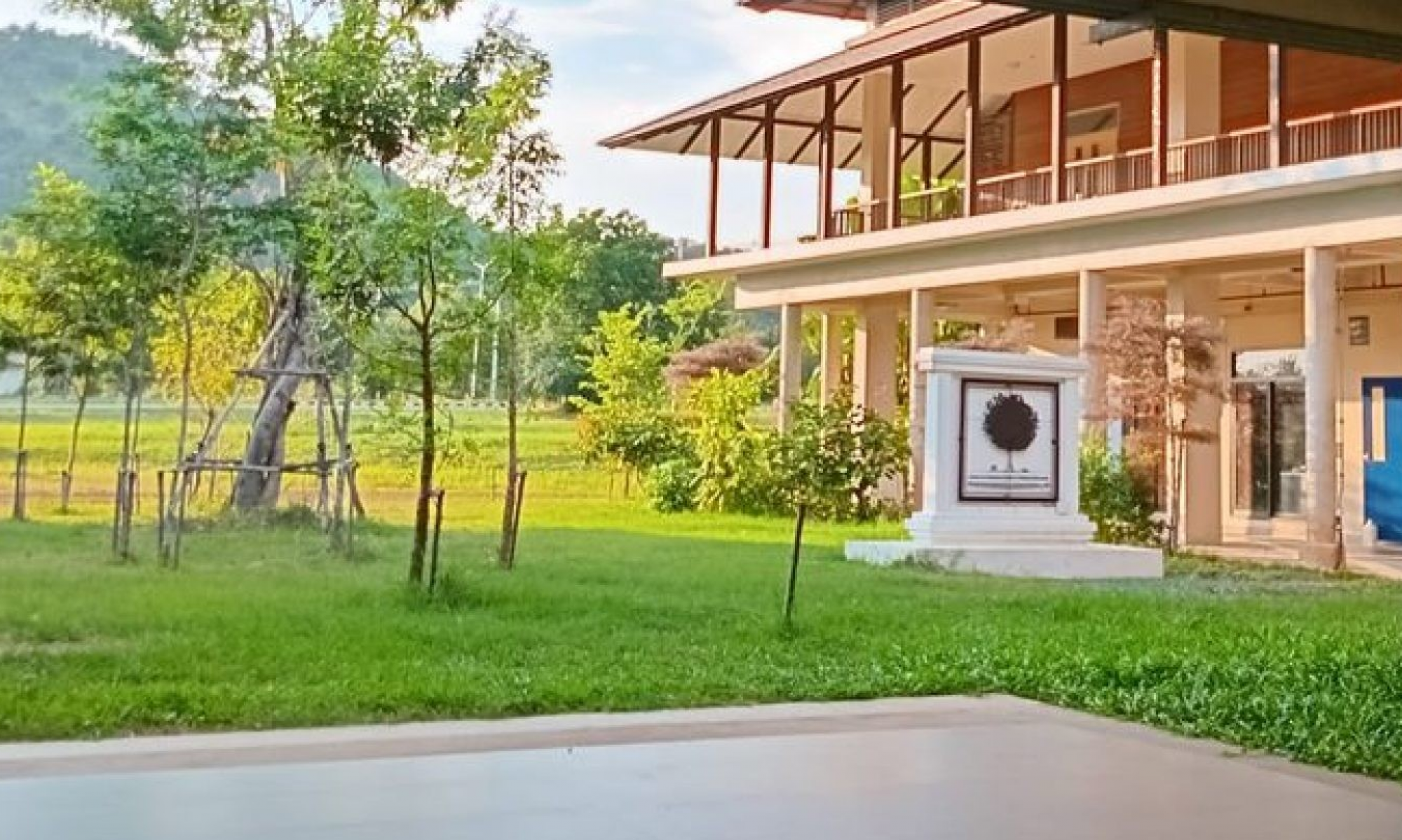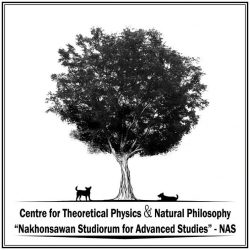NAS Seminar Day
This is an annual one-day seminar event organized as a special Khaothong Seminar at NAS. This seminar welcome external audiences on-site.
(Organizers: Kumar Abhinav, Nandan Roy and Burin Gumjudpai)
Contact: nandan.roy@mahidol.ac.th
2024 NAS Seminar Day (19 Sept 2024)
NAS Seminar Day (19 September 2024): Overview · Indico (narit.or.th)

| Time | Event | Particulars |
| 09:30 | Start of on-site registration | |
| 10:00-10:15 | Inauguration | Speech by VP, Director etc. |
| 10:15-11:15 | Talk 1: Dust after the bang: chemistry in the aftermaths of core-collapse supernovae | Dr. Kaew Samaporn Tinyanont, NARIT |
| 11:15-11:30 | Mini break 1 | |
| 11:30-12:30 | Talk 2: How do hairy black holes grow their hairs? | Dr. Supakchai Ponglertsakul, Silpakorn University |
| 12:30-13:30 | Lunch break | |
| 13:30-14:30 | Talk 3: Exact quasiresonance modes of Kerr-Sen and Kerr-Newman blackhole, ellipsoid singularities, closed-timelike curves and Chronology Protection Conjecture | Dr. Piyabut Burikham, Chulalongkorn University
|
| 14:30-14:45 | Mini break 2 | |
| 14:45-15:45 | Talk 4: Exact quasiresonance modes of Kerr-Sen and Kerr-Newman blackhole, ellipsoid singularities, closed-timelike curves and Chronology Protection Conjecture | Dr. David Senjaya
|
| 15:45-16:15 | Interaction session | Discussion with students and tour of NAS |
| 16:15 | Closing |
Duration of talk: 45 min + 15 min
- Assoc. Prof. Dr. Piyabut Burikham (Chulalongkorn University)
- Dr. David Senjaya (Chulalongkorn University)
Title: Exact quasiresonance modes of Kerr-Sen and Kerr-Newman blackhole, ellipsoid singularities, closed-timelike curves and Chronology Protection Conjecture. (Jointly by Dr. Piyabut Burikham and Dr. David Senjaya)
Abstract: We will discuss Kerr-Sen black hole and its exotic spacetime varieties. Exact solutions of massive and massless scalar fields are solved in both exterior of outer horizon and interior of inner horizon. Quasinormal modes boundary conditions force the QNMs in the interior of inner horizon to be exponentially growing modes. We argue that these QNMs would backreact to spacetime where CTC exist and deform/destroy it. Comparison to Kerr-Sen will be commented.
- Assist. Prof. Dr. Supakchai Ponglertsakul (Silpakorn University)
Title: How do hairy black holes grow their hairs?
Abstract: According to the no-hair theorem, black holes cannot have hairs i.e. distinguish features that can separate them apart from each other. However, many counterexamples have been found in various setups. And black holes with hairs become theoretically possible. In this talk, we shall briefly discuss the no-hair theorem. Then, some examples of hairy black holes will be explored. In particular, we will discuss three mechanisms that allow black holes to grow their hairs, 1) superradiant instability, 2) spontaneous scalarization and 3) spontaneous symmetry breaking.
- Dr. Samaporn Tinyanont (National Astronomical Research Institute of Thailand)
Title: Dust after the bang: chemistry in the aftermaths of core-collapse supernovae
Abstract: Dust is one of the foundational constituents of the Universe. It is the major coolant in dense regions in the interstellar medium (ISM). It absorbs ultraviolet and optical photons that are trapped due to the high optical depth, and re-emits them in the infrared where the radiation can escape. Dust cooling allows the ISM to contract and form stars. Dust forms incredibly early in the Universe; thus, affecting most of its evolution. Multiple observations in the sub-millimeter have shown evidence of a large amount of dust as early as z ~ 8. At that time, known dust-producing systems in the local universe (e.g., asymptotic giant branch stars and other low-mass stellar systems) have yet to evolve. Massive stars, with their short evolutionary timescales, must be the source of dust in the nascent universe. Here, I review dust formation in core-collapse supernovae, the best candidate for the dust forming site in the early universe. Chemical evolution models show that molecules and dust grains are expected to form in large quantities in the aftermath of a core-collapse supernova. Piecemeal observations in the past have shown evidence of a large amount of dust formed in various nearby objects. I will discuss the ongoing effort using systematic observations from the James Webb Space Telescope to survey supernova dust formation on a large scale like never before.

